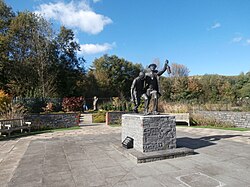Welsh National and Universal Mining Disaster Memorial Garden
| Welsh National and Universal Mining Disaster Memorial Garden | |
|---|---|
 "an important site of public commemoration and memory" | |
| Type | Memorial garden |
| Location | Senghenydd, Caerphilly, Wales |
| Coordinates | 51°36′42″N 3°16′51″W / 51.611735°N 3.2807925°W |
| Official name | Welsh National and Universal Mining Disaster Memorial Garden |
| Designated | 12 March 2024 |
| Reference no. | PGW(Gm)78(CAE) |
| Listing | Grade II |
The Welsh National and Universal Mining Disaster Memorial Garden at
History and description
The
A memorial to the Universal Colliery disasters was unveiled on 14 October 1981 at the gates of the Nant-y-Parc Primary School.
The garden is registered at Grade II on the Cadw/ICOMOS Register of Parks and Gardens of Special Historic Interest in Wales.[d] At the time of its listing, the then First Minister of Wales Mark Drakeford said, "the legacy of coal is still an essential part of our history. It is only right that a site of such symbolic importance as Wales’ National Mining Memorial receives formal recognition".[13] Cadw's listing record for the site describes it as "an important site of public commemoration and memory".[9]
Gallery
-
Postcard of 1913 showing a funeral procession through Senghenydd
-
The 1981 memorial
-
The 2006 memorial
-
The Welsh National Mining Memorial (2013)
-
The remembrance wall
-
Part of the path of memory
Notes
- ^ Although the low level of the fines imposed caused public anger and derision, the inquiry did lead to important improvements in mine safety practices in subsequent decades.[4]
- ^ Johnson’s other commissions include the statue commemorating Keith Park in Waterloo Place and that celebrating Brian Clough in Nottingham.[8]
- ^ Heywood and Land also produce the blue plaques used for commemorations by English Heritage.[11]
- ^ The listing of the garden, on 12 March 2024, made it the most recent addition to the Cadw/ICOMOS Register of Parks and Gardens of Special Historic Interest in Wales, bringing the total number of registered parks and gardens in Wales to 385.[12]
References
- ^ "Universal Colliery, Senghenydd (85091)". Coflein. RCAHMW. Retrieved 28 March 2024.
- ^ "Senghennydd Disaster". National Library of Wales. Retrieved 28 March 2024.
- ^ "1913 Universal Colliery Disaster". Aber Valley Heritage Group. Retrieved 28 March 2024.
- ^ "The Senghenydd Colliery Disaster of 1913". Online Safety Trainer. Retrieved 28 March 2024.
- ^ "Universal Colliery Mining Disasters Memorial, Senghenydd (410287)". Coflein. RCAHMW. Retrieved 28 March 2024.
- ^ "Welsh National Mining Memorial". Art UK. Retrieved 28 March 2024.
- ^ "National Mining Memorial, Senghenydd (419459)". Coflein. RCAHMW. Retrieved 28 March 2024.
- ^ "Les Johnson FRSS". Royal Society of Sculptors. Retrieved 28 March 2024.
- ^ National Historic Assets of Wales. Retrieved 28 March 2024.
- ^ "Welsh National and Universal Mining Memorial Garden, Senghenydd". Caerphilly County Borough Council. Retrieved 28 March 2024.
- ^ Kirka, Danica (19 September 2023). "London's historic blue plaques seek more diversity as 1,000th marker is unveiled". Associated Press. Retrieved 28 March 2024.
- ^ "Parks and gardens". Royal Commission on the Ancient and Historical Monuments of Wales. 24 March 2024. Retrieved 28 March 2024.
- ^ "Site dedicated to thousands of lives lost officially recognised as the National Mining Disaster Memorial Garden of Wales". Welsh Government. 12 March 2024. Retrieved 28 March 2024.







